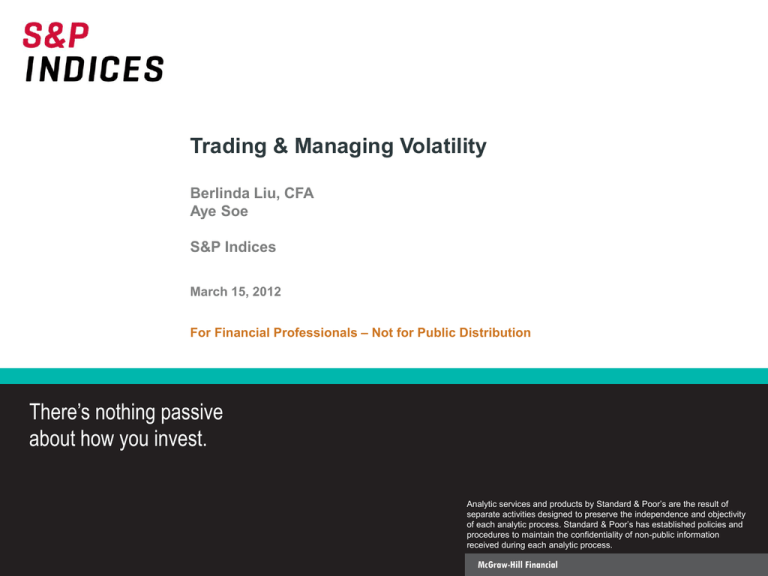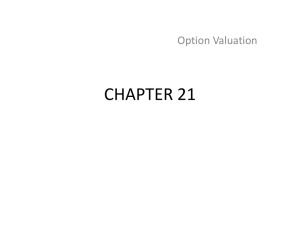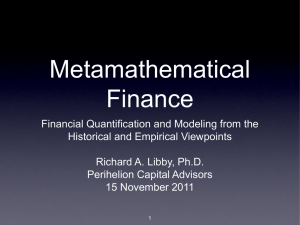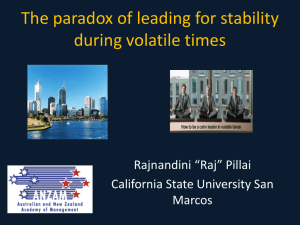
Trading & Managing Volatility
Berlinda Liu, CFA
Aye Soe
S&P Indices
March 15, 2012
For Financial Professionals – Not for Public Distribution
There’s nothing passive
about how you invest.
Analytic services and products by Standard & Poor’s are the result of
PROPRIETARY.
separate
activities designed to preserve the independence and objectivity
Permission
to reprint
or distribute
content
from
this presentation
of
each analytic
process.
Standardany
& Poor’s
has
established
policies requires
and
the
written
approval
of
Standard
&
Poor’s.
Copyright
©
2011
Standard &
procedures to maintain the confidentiality of non-public information
Poor’s Financial
Services
LLC,
a subsidiary of The McGraw-Hill Companies,
received
during each
analytic
process.
Inc. All rights reserved.
McGraw-Hill Financial
Evolution of Volatility Management Indices
Implied
Volatility
Indices
Volatility
Futures
Indices
Intelligent Roll
Volatility
Futures
Indices
Vol-Managed
Enhanced
Equity Indices
1993-2007
2008-2009
2010-2012
2010-2012
Measuring
Trading
PROPRIETARY. Permission to reprint or distribute any content from this presentation requires the written approval of Standard & Poor’s.
Managing
1
How to measure volatility?
Implied
Volatility
Indices
Volatility
Futures
Indices
Intelligent Roll
Volatility
Futures
Indices
Vol-Managed
Enhanced
Equity Indices
1993-2007
2008-2009
2010-2012
2010-2012
•VIX®
•VXV®
Measuring
Trading
PROPRIETARY. Permission to reprint or distribute any content from this presentation requires the written approval of Standard & Poor’s.
Managing
2
The Tale of Two Volatilities
• Implied & Realized Volatility
– Realized volatility is the
standard deviation of the
continuously compounded
returns within a specific time
horizon.
– Implied volatility is the
volatility implied by the
market price of the option
based on an option pricing
model.
• VIX & VXV
– VIX = 1 month implied
volatility of S&P 500®
– VXV = 3 month implied
volatility of S&P 500
– The VIX/VXV ratio measures
expectations of short term
event risk versus longer term
systemic risk. In “normal”
environments, the ratio is
lower than 1.
VIX and VXV are negatively correlated to equity markets, providing
diversification and tail risk hedging benefits. But neither is replicable.
PROPRIETARY. Permission to reprint or distribute any content from this presentation requires the written approval of Standard & Poor’s.
3
How to trade volatility?
Implied
Volatility
Indices
Volatility
Futures
Indices
Intelligent Roll
Volatility
Futures
Indices
Vol-Managed
Enhanced
Equity Indices
1993-2007
2008-2009
2010-2012
2010-2012
•S&P 500 VIX Short
Term VIX Futures
Index ®
•S&P 500 VIX Mid
Term Futures Index ®
•Inverse
•Leveraged
•S&P 500 Dynamic
VIX Futures ®
•S&P 500 VIX Futures
Enhanced Roll ®
•S&P 500 VIX Futures
Term Structure ®
Measuring
Trading
PROPRIETARY. Permission to reprint or distribute any content from this presentation requires the written approval of Standard & Poor’s.
Managing
4
S&P 500 VIX Futures Index Series
• The S&P 500 VIX Short-Term
Futures Index measures the
return from a daily rolling long
position in the first and second
month VIX futures contracts.
• The S&P 500 VIX Mid-Term
Futures Index measures the
return from a daily rolling long
position in the fourth, fifth, sixth
and seventh month VIX futures
contracts.
• Unlike spot VIX, these indices
are replicable. But they have
negative correlation and tail risk
hedging benefits of spot VIX.
Date S&P 500
10/15/2008
-9.46%
12/1/2008
-9.35%
9/29/2008
-9.20%
10/9/2008
-7.92%
11/20/2008
-6.94%
8/8/2011
-6.88%
11/19/2008
-6.30%
10/22/2008
-6.27%
10/7/2008
-5.91%
1/20/2009
-5.43%
11/5/2008
-5.35%
11/12/2008
-5.28%
11/6/2008
-5.13%
2/10/2009
-5.03%
8/4/2011
-4.90%
9/15/2008
-4.83%
9/17/2008
-4.83%
3/2/2009
-4.77%
2/17/2009
-4.64%
8/18/2011
-4.55%
Correlation w/ S&P 500
100%
Correlation w/ VIX Spot
VIX Spot
22.80%
21.46%
29.63%
10.53%
8.51%
40.55%
9.34%
27.11%
3.08%
20.59%
13.37%
7.85%
15.46%
6.71%
30.32%
21.14%
17.85%
12.74%
12.53%
30.10%
S&P 500 VIX S&P 500 VIX
Short Term
Mid Term
Futures Index Futures Index
13.13%
8.06%
12.01%
10.02%
13.11%
7.99%
9.50%
4.92%
5.15%
4.81%
17.44%
6.96%
9.34%
6.33%
9.85%
6.41%
9.17%
0.74%
12.06%
5.86%
6.32%
5.73%
7.44%
2.81%
11.12%
4.62%
6.11%
2.10%
19.35%
8.16%
5.84%
3.09%
5.57%
3.15%
6.35%
2.08%
4.25%
2.54%
17.59%
10.20%
-77%
-80%
-78%
100%
88%
81%
Source: S&P Indices. Correlations are based on daily returns from 12/20/2005 through 1/31/2012. Past performance is no guarantee of future results. Some of the data
used to determine correlations reflects hypothetical historical performance. Please see the Performance Disclosure on slide 22 of this presentation for important
information related to back-tested information.
PROPRIETARY. Permission to reprint or distribute any content from this presentation requires the written approval of Standard & Poor’s.
5
VIX Term Structure
• In the S&P 500 VIX Short-Term
Futures Index, a positive roll
cost occurs on 76% of days,
with an average daily loss of
0.18%.
• In the S&P 500 VIX Mid-Term
Futures Index, a positive roll
cost occurs on 64% of days,
with a lower average daily loss
of 0.07%.
Source: www.cboe.com. 2/15/12
Source: Liu & Dash, Volatility ETFs & ETNs, Journal of Trading, Winter 2012.
PROPRIETARY. Permission to reprint or distribute any content from this presentation requires the written approval of Standard & Poor’s.
6
The Contango Problem
Source: S&P Indices. Based on daily returns from 12/20/2005 through 1/31/2012. Past performance is no guarantee of future results. Some of the information used in this
chart reflects hypothetical historical performance. Please see the Performance Disclosure on slide 22 presentation for important information related to back-tested
information.
PROPRIETARY. Permission to reprint or distribute any content from this presentation requires the written approval of Standard & Poor’s.
7
The Other Side of VIX
• ETPs linked to the inverse of the
S&P 500 VIX Futures Indices
collect positive roll yield when
– The VIX futures curve is in
contango, and
– The VIX spot remains flat or
down
• Inverse VIX Futures ETPs
underperform when VIX rises.
• Available ETPs include
– XIV
– SVXY
Backwardation
Period
Source: S&P Indices, Bloomberg. Based on daily returns through 1/31/2012. Past performance is
no guarantee of future results. It is not possible to invest directly in an index. The comparison in the
chart comparing XIV to the S&P 500 VIX Short-Term Futures is for illustrative purposes only and
does not take costs, fees or other expenses into account. Such costs would lower the actual
performance of any investment. UX1, UX2, UX3 represent generic VIX futures price series of 1month, 2-month and 3-month contracts, respectively. S&P does not sponsor, endorse, promote or
sell any product linked to an S&P Index. For additional information regarding XIV, please see the
Performance Disclosure on page 22.
PROPRIETARY. Permission to reprint or distribute any content from this presentation requires the written approval of Standard & Poor’s.
8
Addressing the Term Structure Decay
• Intelligent roll indices seek to
address the contango problem
by allocating across the term
structure.
• Allocation is typically between
the short and medium end of
the curve.
• Examples
– S&P 500 Dynamic VIX
Futures Index
– S&P 500 VIX Futures Term
Structure Index
– S&P 500 VIX Futures
Enhanced Roll Index
• May involve
– Long and short positions.
– Static or dynamic allocations
PROPRIETARY. Permission to reprint or distribute any content from this presentation requires the written approval of Standard & Poor’s.
9
S&P 500 Dynamic VIX Futures Index
Implied Volatility Term Structure
Target Short-Term
Volatility Allocation
( TS t )
Target Mid-Term
Volatility Allocation
( TM t )
-0.30
0.70
-0.20
0.80
100% ≤ IVTSt-1 < 105%
0.00
1.00
105% ≤ IVTSt-1 ≤ 115%
0.25
0.75
More than 115%
0.50
0.50
( IVTS )
• Dynamically allocates long
and short positions between
Less than 90%
the S&P 500 VIX Short and
Medium Term Futures Indices. 90% ≤ IVTS < 100%
t-1
t-1
• Allocations driven by the
Implied Volatility Term
Structure (IVST)
IVTSt-1 = VIXt-1/VXVt-1
Graduated daily changes towards target positions by limiting
daily change to 12.5%
PROPRIETARY. Permission to reprint or distribute any content from this presentation requires the written approval of Standard & Poor’s.
10
Preserving the Tail Risk Hedge Benefits
Source: S&P Indices. Correlations are
based on daily returns from 12/20/2005
through 1/31/2012. Past performance is
no guarantee of future results. Some of
the data used to determine correlations
reflects hypothetical historical
performance. Please see the
Performance Disclosure on slide 22
presentation for important information
related to back-tested information.
Date
S&P 500
10/15/2008
-9.46%
12/1/2008
-9.35%
9/29/2008
-9.20%
10/9/2008
-7.92%
11/20/2008
-6.94%
8/8/2011
-6.88%
11/19/2008
-6.30%
10/22/2008
-6.27%
10/7/2008
-5.91%
1/20/2009
-5.43%
11/5/2008
-5.35%
11/12/2008
-5.28%
11/6/2008
-5.13%
2/10/2009
-5.03%
8/4/2011
-4.90%
9/15/2008
-4.83%
9/17/2008
-4.83%
3/2/2009
-4.77%
2/17/2009
-4.64%
8/18/2011
-4.55%
Correlation w/ S&P 500
100%
Correlation w/ VIX Spot
VIX Spot
22.80%
21.46%
29.63%
10.53%
8.51%
40.55%
9.34%
27.11%
3.08%
20.59%
13.37%
7.85%
15.46%
6.71%
30.32%
21.14%
17.85%
12.74%
12.53%
30.10%
S&P 500 VIX
Short Term
Futures Index
13.13%
12.01%
13.11%
9.50%
5.15%
17.44%
9.34%
9.85%
9.17%
12.06%
6.32%
7.44%
11.12%
6.11%
19.35%
5.84%
5.57%
6.35%
4.25%
17.59%
S&P 500 VIX
Mid Term S&P 500 Dynamic
Futures Index VIX Futures Index
8.06%
10.63%
10.02%
10.27%
7.99%
9.30%
4.92%
7.24%
4.81%
4.90%
6.96%
9.69%
6.33%
7.09%
6.41%
8.14%
0.74%
5.04%
5.86%
2.24%
5.73%
5.88%
2.81%
3.99%
4.62%
5.46%
2.10%
1.06%
8.16%
11.08%
3.09%
2.42%
3.15%
3.46%
2.08%
2.08%
2.54%
1.19%
10.20%
12.10%
-77%
-80%
-78%
-72%
100%
88%
81%
65%
PROPRIETARY. Permission to reprint or distribute any content from this presentation requires the written approval of Standard & Poor’s.
11
Navigating the Term Structure
S&P 500 VIX S&P 500 VIX
Short Term Mid Term
S&P 500
Futures
Futures Dynamic VIX
S&P 500 VIX Spot
Index
Index Futures Index
Return
1 Year
2 Years
3 Years
5 Years
Volatility
1 Year
2 Years
3 Years
5 Years
4.22% -0.46%
12.84% -11.14%
19.24% -24.31%
0.33% 13.28%
23.40%
20.73%
22.40%
26.72%
130.79%
122.75%
111.88%
119.46%
-15.55%
-53.64%
-59.43%
-23.22%
-5.16%
-13.33%
-18.41%
11.46%
17.02%
16.37%
10.22%
34.36%
77.85%
69.77%
63.50%
64.52%
38.97%
34.89%
32.23%
34.41%
31.14%
24.41%
22.23%
27.63%
Source: S&P Indices. Returns and volatility are annualized figures for 1, 2, 3 and 5 year
periods ending 1/31/2012. Past performance is no guarantee of future results. Some of
the data used to determine returns and volatility reflect hypothetical historical
performance. Please see the Performance Disclosure on slide 22 presentation for
important information related to back-tested information.
PROPRIETARY. Permission to reprint or distribute any content from this presentation requires the written approval of Standard & Poor’s.
12
How to manage volatility in an equity portfolio?
Implied
Volatility
Indices
Volatility
Futures
Indices
Intelligent Roll
Volatility
Futures
Indices
Vol-Managed
Enhanced
Equity Indices
1993-2007
2008-2009
2010-2012
2010-2012
•S&P 500 VEQTOR®
•S&P 500 Low Volatility ®
•S&P 500 Risk Control
Measuring
Trading
PROPRIETARY. Permission to reprint or distribute any content from this presentation requires the written approval of Standard & Poor’s.
Managing
13
Volatility Managed S&P 500
Managing Volatility of S&P 500 Exposure
Using VIX Derivatives
Overlay
Using Stock Selection &
Alternative Weighting
Allocating Between
Risky and Risk-Free
Assets
S&P 500
VEQTOR®
S&P 500
Low Volatility®
S&P 500
Risk Control
PROPRIETARY. Permission to reprint or distribute any content from this presentation requires the written approval of Standard & Poor’s.
14
VEQTOR – Volatility Equity Allocator
Step 1: Evaluate realized and implied volatility
Step 2: Establish implied volatility trend
Let RV and IV denote annualized one-month realized and implied
volatility, respectively, where:
The implied volatility trend evaluates the presence, or lack, of a
trend of expected volatility implied by the options markets. Let the
five-day and 20-day implied volatility average be denoted by 5IVt
and 20IVt , respectively. The Daily Implied Volatility Trend
indicator ( DIVTt ) is up (+1) if the five-day implied volatility
average is greater than or equal to the 20-day implied volatility
average, and down (-1) if it is less.
RVt 1 =
IVt 1
22
SPXt n
252* ln
n 1
SPXt n 1
22
= VIX t 1
2
(1)
(2)
5
5IVt 1 =
IVt n
5
(3)
20
20IVt 1 =
IVt n
20
(4)
n 1
where:
VIXt-1 and SPXt refer to the CBOE Volatility Index (VIX)
and the S&P 500 price return index, respectively.
n 1
1if 5IVt 1 20IVt 1
DIVTt 1
1if 5IVt 1 20IVt 1
(5)
The Implied Volatility Trend ( IVTt ) is established if the Daily
Implied Volatility Trend indicators remain constant for at least 10
business days. Uptrend (+1), Downtrend (-1) and No Trend (0) are
given by the following formulae:
IVTt 1
10
1
...
if
DIVTt n 10
n 1
10
1 if DIVTt n 10
n 1
10
0 if 10 DIVTt n 10
n 1
PROPRIETARY. Permission to reprint or distribute any content from this presentation requires the written approval of Standard & Poor’s.
(6)
15
VEQTOR – Volatility Equity Allocator
Step 3: Divide 100% of portfolio between volatility and equity
Target Volatility Allocation
Vol
Realized Volatility
( RVt 1 )
( wt
)
Implied Volatility
Downtrend
No Implied
Volatility Trend
Implied Volatility
Uptrend
( IVTt 1 ) = -1
( IVTt 1 ) = 0
( IVTt 1 ) = +1
Less than 10%
2.5%
2.5%
10.0%
10% ≤ RVt-1 < 20%
2.5%
10.0%
15.0%
20% ≤ RVt-1 < 35%
10.0%
15.0%
25.0%
35% ≤ RVt-1 ≤ 45%
15.0%
25.0%
40.0%
More than 45%
25.0%
40.0%
40.0%
wtVol
= Weight of the volatility component
wtEquity = Weight of the S&P 500
= 100% - wtVol
Step 4: Impose stop loss discipline
At the close of any business day, if losses over the prior five
business days are greater than or equal to 2%, then the index
moves into a 100% cash position.
PROPRIETARY. Permission to reprint or distribute any content from this presentation requires the written approval of Standard & Poor’s.
16
Dynamic Allocation in Action
Reduced volatility exposure
in benign environment
Higher volatility exposure
(up to 40%) in stress environment
Source: S&P Indices. Based on daily returns from 12/20/2005 through 1/31/2012. Past performance is no guarantee of future results. Some of the information
used in this chart reflects hypothetical historical performance. Please see the Performance Disclosure on slide 22 presentation for important information related to
back-tested information.
PROPRIETARY. Permission to reprint or distribute any content from this presentation requires the written approval of Standard & Poor’s.
17
Dynamic Allocation in Action
Risk-Return Statistics
S&P 500
Annual Returns
S&P 500 S&P 500 Low
VEQTOR
Volatility
S&P 500
S&P 500
VEQTOR
S&P 500 Low
Volatility
Annualized Returns
2006
15.79%
14.15%
19.69%
15.13%
2007
5.49%
17.20%
0.58%
15.48%
16.73%
2008
-37.00%
21.29%
-21.41%
16.29%
3.85%
2009
26.46%
23.39%
19.22%
2010
15.06%
1.65%
13.36%
2011
2.11%
17.41%
14.78%
1 Year
4.22%
18.47%
14.56%
2 Years
12.84%
11.96%
3 Years
19.24%
5 Years
0.33%
Risk Stats
5 Year
Volatility
5 Year
Return/Risk
18.83%
16.26%
12.82%
0.017
1.002
0.300
Correlation with S&P 500 using Daily Returns
100%
61.72%
93.86%
Correlation with S&P 500 using Monthly Returns
100%
6.47%
Source: S&P Indices. Returns and volatility are annualized figures
for 1, 2, 3 and 5 year periods ending 1/31/2012. Past performance
is no guarantee of future results. Some of the data used to
determine returns and volatility reflect hypothetical historical
performance. Please see the Performance Disclosure on slide 22
presentation for important information related to back-tested
information
90.60%
PROPRIETARY. Permission to reprint or distribute any content from this presentation requires the written approval of Standard & Poor’s.
18
Low Volatility Investing: Research
• Low volatility investing has been around for over 40 years.
• Black, Jensen and Scholes (1972) first strategized that low risk
stocks may earn high risk-adjusted returns.
• Fama and French (1992); Blitz and van Vliet (2007); and Baker,
Bradley and Wurgler (2011) followed up that high beta or high
volatility stocks are not rewarded with higher returns. These studies
involved quantile portfolios based on ranking of securities on a risk
measure.
• Clarke, de Silva, and Thorley (2006) demonstrated using
mean/variance optimization that minimum variance portfolios earn
higher return with lower realized risk.
PROPRIETARY. Permission to reprint or distribute any content from this presentation requires the written approval of Standard & Poor’s.
19
Constructing Low Volatility Indices
Approach # 1 – Optimization Based Low Volatility Portfolio
• Minimum variance portfolio based on optimization models
• Risk reduction is achieved through estimated factor models or
covariance matrices.
• Used by MSCI and Russell
Approach # 2 – Ranking Based Low Volatility Portfolio
• Portfolio of securities that are least volatile based on a past
volatility measure
• Risk reduction is achieved through selection of lower volatility
securities (or conversely, removal of higher volatility securities)
• Used by S&P Indices
Research shows that both approaches are effective at reducing
portfolio volatility over a long-term investment horizon by 25-30%.
PROPRIETARY. Permission to reprint or distribute any content from this presentation requires the written approval of Standard & Poor’s.
20
The Case for Low Volatility Investing
S&P 500 Low
Volatility Index
Annualized Return
1 Year
14.78%
3 Year
15.76%
5 Year
4.16%
10 Year
7.24%
15 Year
8.53%
20 Year
9.85%
Annualized Standard Deviation
1 Year
8.73%
3 Year
11.90%
5 Year
12.92%
10 Year
10.81%
15 Year
12.18%
20 Year
11.37%
Sharpe Ratio
3 Year
1.314
5 Year
0.229
10 Year
0.501
15 Year
0.466
20 Year
0.580
Russell-Axioma U.S.
MSCI US Min. Vol
Large Cap Low
Index
Volatility Index
S&P 500
6.39%
12.26%
2.62%
N/A
N/A
N/A
12.87%
15.29%
3.20%
4.76%
N/A
N/A
2.11%
14.11%
-0.25%
2.92%
5.45%
7.81%
11.96%
14.21%
14.09%
N/A
N/A
N/A
9.77%
14.45%
14.93%
12.32%
N/A
N/A
15.94%
18.97%
18.88%
15.93%
16.59%
15.03%
0.854
0.100
N/A
N/A
N/A
1.049
0.134
0.238
N/A
N/A
0.737
-0.077
-0.085
-0.117
0.304
Data from 12/31/1990 - 12/31/2011. Returns are total return in USD. Data for MSCI US Minimum Volatility is from www.msci.com. Data for Russell is from
www.russell.com. Graphs are provided for illustrative purposes only. Past performance is not a guarantee of future results. This graph reflects hypothetical
historical performance. Please see the Performance Disclosure at the end of this document for more information regarding the inherent limitations associated with
backtested performance.
PROPRIETARY. Permission to reprint or distribute any content from this presentation requires the written approval of Standard & Poor’s.
21
Performance Disclaimer
The inception date of the S&P 500 VIX Short Term Futures Index and the S&P 500 VIX Mid Term Futures Index was January 22, 2009, at the market close. All information
presented prior to the index inception date is back-tested. The back-test calculations are based on the same methodology that was in effect when the index was officially
launched. Complete index methodology details are available at www.indices.standardandpoors.com.
The inception date of the S&P 500 Dynamic VIX Futures Index was June 29, 2011 at the market close. All information presented prior to the index inception date is backtested. The back-test calculations are based on the same methodology that was in effect when the index was officially launched. Complete index methodology details are
available at www.indices.standardandpoors.com.
The inception date of the S&P 500 Dynamic VEQTOR Index was November 18, 2009, at the market close. All information presented prior to the index inception date is backtested. The back-test calculations are based on the same methodology that was in effect when the index was officially launched. Complete index methodology details are
available at www.indices.standardandpoors.com.
The inception date of the S&P 500 Low Volatility Index was April 18, 2011, at the market close. All information presented prior to the index inception date is back-tested. The
back-test calculations are based on the same methodology that was in effect when the index was officially launched. Complete index methodology details are available at
www.indices.standardandpoors.com.
The VelocityShares Daily Inverse VIX Short-Term ETN (XIV) inception date was 11/29/10 and has a maturity date of 12/4/30. XIV are senior, unsecured obligations of Credit
Suisse AG. The returns on the ETNs are linked to the inverse of the daily performance of the S&P 500 VIX Short-Term Futures™ Index ER less the investor fee. On any
calendar day, the Daily Investor Fee is equal to the product of (1) the Closing Indicative on the immediately preceding calendar day multiplied by (2) the Daily ETN
Performance for that series on such calendar day multiplied by (3) the quotient of (a) 0.0135 divided by (b) 365. The ETNs provide traders with an exchange traded instrument
enabling them to efficiently express their market views on the short-term futures contracts on the CBOE SPX Volatility Index® (the “VIX®”). The ETNs do not guarantee any
return of principal at maturity and do not pay any interest during their term. The index was designed to provide investors with exposure to one or more maturities of futures
contracts on the VIX®, which reflects implied volatility of the S&P 500® Index at various points along the volatility forward curve. The calculation of the VIX® is based on prices
of put and call options on the S&P 500® Index. The S&P 500 VIX Short-Term Futures™ Index ER targets a constant weighted average maturity of 1 month. The ETNs are
linked to the daily inverse return of the index and do not represent an investment in the inverse of the VIX®. The ETNs are not sponsored, endorsed, sold or promoted by S&P
or CBOE and S&P and CBOE make no representation regarding the advisability of investing in the ETNs.
Past performance is not an indication of future results. Prospective application of the methodology used to construct the S&P 500 VIX Short Term Futures Index, the S&P 500
VIX Mid Term Futures Index, the S&P 500 Dynamic VIX Futures Index, the S&P 500 Dynamic VEQTOR Index and the S&P 500 Low Volatility Index may not result in
performance commensurate with the back-test returns shown. The back-test period does not necessarily correspond to the entire available history of the index. Please refer to
the methodology paper for the index, available at www.standardandpoors.com for more details about the index, including the manner in which it is rebalanced, the timing of
such rebalancing, criteria for additions and deletions, as well as all index calculations. It is not possible to invest directly in an Index.
Also, another limitation of hypothetical information is that generally the index is prepared with the benefit of hindsight. Back-tested data reflect the application of the index
methodology and selection of index constituents in hindsight. No hypothetical record can completely account for the impact of financial risk in actual trading. For example,
there are numerous factors related to the equities (or fixed income, or commodities) markets in general which cannot be, and have not been accounted for in the preparation of
the index information set forth, all of which can affect actual performance.
The index returns shown do not represent the results of actual trading of investor assets. Standard & Poor’s maintains the indices and calculates the index levels and
performance shown or discussed, but does not manage actual assets. Index returns do not reflect payment of any sales charges or fees an investor would pay to purchase the
securities they represent. The imposition of theses fees and charges would cause actual and back-tested performance to be lower than the performance shown. In a simple
example, if an index returned 10% on a US $100,000 investment for a 12-month period (or US$ 10,000) and an actual asset-based fee of 1.5% were imposed at the end of the
period on the investment plus accrued interest (or US$ 1,650), the net return would be 8.35% (or US$ 8,350) for the year. Over 3 years, an annual 1.5% fee taken at year end
with an assumed 10% return per year would result in a cumulative gross return of 33.10%, a total fee of US$ 5,375, and a cumulative net return of 27.2% (or US$ 27,200).
VIX® is a registered trademark of Chicago Board Options Exchange, Incorporated. The VIX methodology is the property of the Chicago Board Options Exchange ("CBOE").
CBOE has granted Standard & Poor’s Financial Services LLC ("S&P"), a license to use the VIX methodology to create the S&P 500 Dynamic VIX, S&P 500 VIX Mid-Term
Futures Index, S&P 500 VIX Short-Term Futures Index, S&P 500 VIX 2-Month Futures Index, S&P 500 VIX 3-Month Futures Index, S&P 500 VIX 4-Month Futures Index, and
S&P 500 VIX 6-Month Futures Index.
PROPRIETARY. Permission to reprint or distribute any content from this presentation requires the written approval of Standard & Poor’s.
22
General Disclaimer
This document does not constitute an offer of services in jurisdictions where Standard & Poor’s Financial Services LLC (“S&P”) or its affiliates do not
have the necessary licenses. All information provided by S&P is impersonal and not tailored to the needs of any person, entity or group of persons. S&P
receives compensation in connection with licensing its indices to third parties. Any returns or performance provided within are for illustrative purposes
only and do not demonstrate actual performance. Past performance is not a guarantee of future investment results.
It is not possible to invest directly in an index. Exposure to an asset class represented by an index is available through investable instruments based on
that index. S&P and its affiliates do not sponsor, endorse, sell, promote or manage any investment fund or other vehicle that is offered by third parties
and that seeks to provide an investment return based on the returns of any S&P index. There is no assurance that investment products based on the
index will accurately track index performance or provide positive investment returns. S&P is not an investment advisor, and S&P and its affiliates make
no representation regarding the advisability of investing in any such investment fund or other vehicle. A decision to invest in any such investment fund
or other vehicle should not be made in reliance on any of the statements set forth in this document. Prospective investors are advised to make an
investment in any such fund or other vehicle only after carefully considering the risks associated with investing in such funds, as detailed in an offering
memorandum or similar document that is prepared by or on behalf of the issuer of the investment fund or other vehicle. Inclusion of a security within an
index is not a recommendation by S&P to buy, sell, or hold such security, nor is it considered to be investment advice.
The index returns shown do not represent the results of actual trading of investor assets. Standard & Poor’s maintains the indices and calculates the
index levels and performance shown or discussed, but does not manage actual assets. Index returns do not reflect payment of any sales charges or
fees an investor would pay to purchase the securities they represent. The imposition of theses fees and charges would cause actual and back-tested
performance to be lower than the performance shown. In a simple example, if an index returned 10% on a US $100,000 investment for a 12-month
period (or US$ 10,000) and an actual asset-based fee of 1.5% were imposed at the end of the period on the investment plus accrued interest (or US$
1,650), the net return would be 8.35% (or US$ 8,350) for the year. Over 3 years, an annual 1.5% fee taken at year end with an assumed 10% return per
year would result in a cumulative gross return of 33.10%, a total fee of US$ 5,375, and a cumulative net return of 27.2% (or US$ 27,200).
S&P does not guarantee the accuracy and/or completeness of any S&P index, any data included therein, or any data from which it is based, and
Standard & Poor’s shall have no liability for any errors, omissions, or interruptions therein. S&P makes no warranties, express or implied, as to results
to be obtained from use of information provided by S&P, and S&P expressly disclaims all warranties of suitability with respect thereto. While S&P has
obtained information believed to be reliable, S&P shall not be liable for any claims or losses of any nature in connection with information contained in
this document, including but not limited to, lost profits or punitive or consequential damages, even if it is advised of the possibility of same.
S&P keeps certain activities of its business units separate from each other in order to preserve the independence and objectivity of their respective
activities. As a result, certain business units of S&P may have information that is not available to other S&P business units. S&P has established
policies and procedures to maintain the confidentiality of non-public information received during each analytic process. S&P and its affiliates provide a
wide range of services to, or relating to, many organizations, including issuers of securities, investment advisers, broker-dealers, investment banks,
other financial institutions and financial intermediaries, and accordingly may receive fees or other economic benefits from those organizations, including
organizations whose securities or services they may recommend, rate, include in model portfolios, evaluate or otherwise address.
Copyright © 2012 by Standard & Poor’s Financial Services LLC, a subsidiary of The McGraw-Hill Companies. All rights reserved. Redistribution,
reproduction and/or photocopying in whole or in part is prohibited without written permission. STANDARD & POOR’S, S&P and S&P 500 are registered
trademarks of Standard & Poor’s Financial Services LLC.
PROPRIETARY. Permission to reprint or distribute any content from this presentation requires the written approval of Standard & Poor’s.
23
For questions, please contact:
berlinda_liu@standardandpoors.com
aye_soe@standardandpoors.com
Analytic services and products by Standard & Poor’s are the result of
separate activities designed to preserve the independence and objectivity
of each analytic process. Standard & Poor’s has established policies and
procedures to maintain the confidentiality of non-public information
received during each analytic process.
McGraw-Hill
Financial
PROPRIETARY. Permission to reprint or distribute any content from this presentation requires the written approval of Standard
& Poor’s.
24









